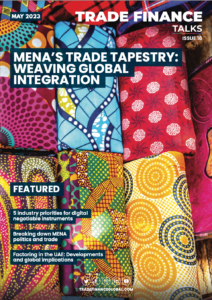The 2030 Agenda for Sustainable Development of the United Nations defines international trade as “an engine for inclusive economic growth and poverty reduction that contributes to the promotion of sustainable development”.
Trade is critical in advancing economies, including those in the MENA region. At the same time, trade finance presents unique opportunities for criminal exploitation, also referred to as Trade Based Financial Crime (TBFC). The inherent risks of trade finance are high and include money-laundering considerations, potential sanctions violations, the vulnerability of cross-border transactions to fraud and terrorist financing, as well as the use of dual-purpose goods for nuclear proliferation.
As the MENA region includes countries subject to sanctions, parallel challenges emerge when non-sanctioned countries need to manage the effect of U.S. and E.U. sanctions. Closer proximity to sanctioned countries increases the risk of exposure to schemes that attempt to exploit loopholes in trade restrictions.
Additional challenges arise due to limited MENA-specific financial crime typologies of trade finance, which can both raise awareness of real threats and increase the ability of practitioners to identify TBFC. This deficit creates a limited feedback loop on key financial crime indicators among public and private sector actors.
Combating TBFC Efforts in the MENA Region
The recipe to enhance efforts to combat TBFC in the MENA region requires a blend of capacity building, enhanced collaboration between the public and private sectors, as well as digitalisation of processes.
1. Capacity building
Detecting TBFC is no easy task. It requires a deep dive into due diligence reviews to understand a customer’s trading activity, counterparties, and the analysis of trade-related data. This includes vessels, ports, dual-use goods, involvement of free zone companies and shipping information.
This scrutiny needs to be applied while keeping pace with evolving TBFC typologies, including those that exploit advanced technology. Banks in particular need to remain vigilant to continually evolving sanction evasion techniques. There are many different methods of concealing the involvement of a sanctioned party in a trade:
- Concealing the end user’s identity, consolidating goods,
- Using neutral jurisdictions,
- Switching cargo on the open sea,
- Concealing the final destination of goods,
- Using transferable & back-to-back letters of credit,
- Concealing beneficial ownership.
The challenge is compounded for MENA banks, as sanctions evasion techniques misuse the Arabic language including by Romanising Arabic letters. By distorting the names of the parties, it is harder to identify matches to names and aliases included on sanctions lists.
When sanctions evasion is successful, a transaction that is restricted or prohibited unwittingly clears, resulting in significant TBFC risks including litigation exposure. Sanctions evaders often understand the rules on due diligence, filters, and name screening and dedicate time to bypassing these controls without detection.
Manufacturing, packaging, and shipping companies are at times also complicit in these evasion efforts, adding a further layer of concealment for banks and trade partners to contend with. In essence, targeted capacity building is critical to minimising the intrinsic TBFC risks in the rapidly evolving trade environment.
2. Enhanced collaboration
Partnership between the public and private sectors is critical for TBFC, particularly as it relates to Trade Based Terror Finance. Key stakeholders from the public sector include law enforcement, prosecutors, Financial Intelligence Units (FIUs), tax authorities, and customs agencies.
Government authorities need to engage with the financial services industry through Public-Private Partnerships (PPPs), a critical tool for enhancing the effectiveness of counter-financial crime efforts. PPPs support collaboration and information sharing and facilitate the building of trust and communication among stakeholders.
This allows public and private sectors and law enforcement to align their understanding of risks and priorities in the counter-financial crime system. By breaking down siloed efforts, PPPs provide a holistic view of the TBFC lifecycle and thereby improve the quality of SARs and law enforcement outcomes, including prosecutions and confiscations. This enhanced understanding can feed into MENA-specific TBFC typology reports efficiently communicated to benefit the wider community.

3. The digitalisation of processes
Because trade-related transactions are often complex and multi-jurisdictional, innovative IT solutions, such as graph analytics, artificial intelligence (AI), machine learning (ML), and digital ledger technology (DLT) are particularly helpful in TBFC-related analysis.
These solutions can be used not only to analyse large data sets, but also to fill in missing links in existing networks (for example, identifying unknown criminal networks based on known criminal networks) and pinpointing interactions that indicate fictitious trade activities.
On the other hand, recent Optical Character Recognition technology (OCR) extracts data from documents, tracks vessels in real time, monitors red flags, and validates prices. Separately, DLT, which incorporates sanctions screening, allows parties to upload and encrypt physical documents involved in a trade financing transaction, enabling all stakeholders to view such documents simultaneously and securely. This eliminates the need for stakeholders to manage and reconcile physical documents, dramatically increasing efficiencies including for TBFC defences.
Call to action
In October 2022, the Global Coalition to Fight Financial Crime – MENA Chapter (GCFFC), in collaboration with the MENA Financial Crime Compliance Group (MENA FCCG) launched a comprehensive Trade Based Financial Crime (TBFC) Reference Guide.
The Guide, available in both Arabic and English and posted on the MENA FCCG website was created by leading experts with a specific focus on how TBFC methodologies are experienced in the MENA region. It aims to provide a single, accessible source of knowledge on how the trade system is abused and what methods are available to detect these illegal practices.
The GCFFC and MENA FCCG are also working closely with the American University of Beirut (AUB) on developing a TBFC Diploma and Certification open to all key stakeholders, including compliance professionals from the financial services industry, FIUs, law enforcement, customs agencies, and consultancy firms.
Its purpose is to build a community of practitioners with a developed understanding of TBFC issues, equipped with the right skill set to pursue a career in an industry that, in the modern world, increasingly requires a high level of technical expertise.
The TBFC Diploma and Certification will also benefit from the formation of a dedicated TBFC Working Group of subject matter experts from leading banks across MENA. This working group will serve to open dialogue and share leading practices across the region, including on evolving topics like advanced technology.
This will ensure that the course content is reflective of current thinking and that students have access to insights into how the industry is adapting to new threats and progressing across practices.
Combating financial crime, including the exploitation of trade finance, is a persistent challenge. It can only be addressed with the intense commitment of all key stakeholders, who must be guided by their moral compass to support the good of their communities.
A well-trained workforce with hands-on experience in detecting and preventing the criminal exploitation of trade finance can dramatically improve the detection of TBFC, meet regulatory obligations, and make a collective impact in reducing financial crime.
This article was a joint collaboration between MENA FCCG and GCFFC (MENA).











































